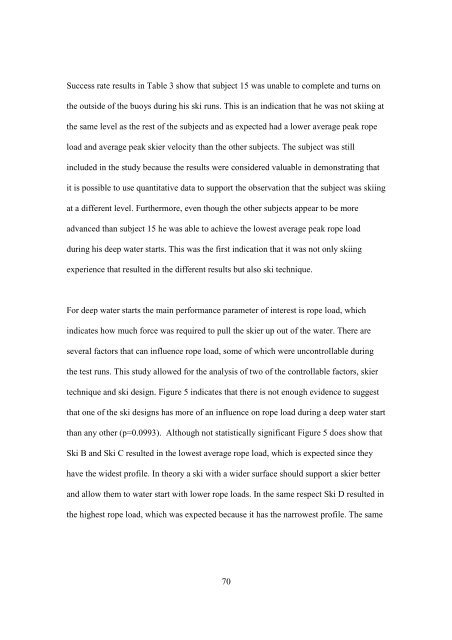Biomechanical P ... Slalom Water Skiing R1.pdf - Atrium - University ...
Biomechanical P ... Slalom Water Skiing R1.pdf - Atrium - University ...
Biomechanical P ... Slalom Water Skiing R1.pdf - Atrium - University ...
- No tags were found...
Create successful ePaper yourself
Turn your PDF publications into a flip-book with our unique Google optimized e-Paper software.
Success rate results in Table 3 show that subject 15 was unable to complete and turns onthe outside of the buoys during his ski runs. This is an indication that he was not skiing atthe same level as the rest of the subjects and as expected had a lower average peak ropeload and average peak skier velocity than the other subjects. The subject was stillincluded in the study because the results were considered valuable in demonstrating thatit is possible to use quantitative data to support the observation that the subject was skiingat a different level. Furthermore, even though the other subjects appear to be moreadvanced than subject 15 he was able to achieve the lowest average peak rope loadduring his deep water starts. This was the first indication that it was not only skiingexperience that resulted in the different results but also ski technique.For deep water starts the main performance parameter of interest is rope load, whichindicates how much force was required to pull the skier up out of the water. There areseveral factors that can influence rope load, some of which were uncontrollable duringthe test runs. This study allowed for the analysis of two of the controllable factors, skiertechnique and ski design. Figure 5 indicates that there is not enough evidence to suggestthat one of the ski designs has more of an influence on rope load during a deep water startthan any other (p=0.0993). Although not statistically significant Figure 5 does show thatSki B and Ski C resulted in the lowest average rope load, which is expected since theyhave the widest profile. In theory a ski with a wider surface should support a skier betterand allow them to water start with lower rope loads. In the same respect Ski D resulted inthe highest rope load, which was expected because it has the narrowest profile. The same70
















